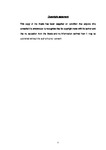Characterization of cholinesterase activities for pesticide exposure in food animals
| dc.contributor.supervisor | Moody, A. John | |
| dc.contributor.author | Abass Askar, Kasim Sakran | |
| dc.contributor.other | Faculty of Science and Engineering | en_US |
| dc.date.accessioned | 2012-09-21T09:30:46Z | |
| dc.date.available | 2012-09-21T09:30:46Z | |
| dc.date.issued | 2012 | |
| dc.identifier | 10173014 | en_US |
| dc.identifier.uri | http://hdl.handle.net/10026.1/1193 | |
| dc.description.abstract |
The primary aim of the work described in this thesis is to establish a foundation for the applicability of a biochemical biomarker, cholinesterase (ChE) activity in food animal species, as an instrument for evaluating exposure to pollutants as well as predicting high-level effects on public health. Secondary aims are to increase the awareness of pesticide users of anti-ChE exposure, to decide whether poisoning episodes involve anti-ChE by measuring residual effects in tissues, and to identify sources of contamination in food animal tissues. The ChE are specialized carboxylic ester hydrolases that break down esters of choline. They are classified as either acetylcholinesterase (AChE) or butyrylcholinesterase (BChE). Both AChE and BChE activities were found to be higher in cattle than in sheep and higher in erythrocytes than in plasma and serum. The anticoagulant heparin significantly affects AChE activity in plasma compared with EDTA. Of the different tissue tested, the mean of ChE activities was found to be highest in tissue from the liver, followed by lung, muscle, kidney and heart for sheep and cattle. In pigs, the ChE activities tested higher in kidney, liver, lung, muscle and heart. The effect of freezing on ChE activities in liver and muscle tissues was significant inhibition after 6 months at -80 °C, whereas decreased after 3 months at -20 °C. A technique to improve the purification of AChE in sheep tissue was developed. BW284c51 strongly reduced acetylthiocholine iodide (AcTChI) and propionylthiocholine iodide (PrTChI) hydrolysis and slightly affected that of butyrylthiocholine iodide (BuTChI) in the liver, while iso-OMPA had no significant effect for muscle BuTChI of sheep and pigs. Histochemical study of liver tissue found AChE localised mainly in the cytoplasm of the cell lining in the sinusoids. The optimal pH values of AChE and BChE in liver and muscle ranged between 7.8 and 8.5. Both AChE and BChE activities increased when increase the time course and temperature. The half maximal inhibitory concentration (IC50) was found to be higher for carbaryl than dichlorvos (DDVP) and diazinon (DZN). Very little residual AChE activity was seen in the liver, but more was found in muscles. In general, the rate constants of inhibition (ki) values for liver and muscles were increased in different pHs according to the rank order of 8.5 > 7.5 > 6.5, while in plasma it was decreased in different temperatures as follows: 20 °C > 30 °C > 40 °C. The final experiments were carried out at the rate of spontaneous reactivation (ks) of inhibited AChE by DDVP and DZN from liver and muscle was found to be higher in sheep compared to cattle and pig, while the aging of phosphorylated AChE (ka) was found to be higher in cattle compared to sheep and pig. In addition, this study indicated that the developed bispyridinium symmetric (K048) oxime seems to be promising reactivated to DDVP-inhibited AChE for sheep and pigs while HI-6 was effective in cattle. | en_US |
| dc.description.sponsorship | The Ministry of Higher Education and Scientific Research/ Republic of Iraq | en_US |
| dc.language.iso | en | en_US |
| dc.publisher | University of Plymouth | en_US |
| dc.subject | Cholinesterase | en_US |
| dc.subject | Pesticide | en_US |
| dc.subject | Biochemical biomarker | en_US |
| dc.subject | Food animals | en_US |
| dc.title | Characterization of cholinesterase activities for pesticide exposure in food animals | en_US |
| dc.type | Thesis | |
| plymouth.version | Full version | en_US |
| dc.identifier.doi | http://dx.doi.org/10.24382/4883 |
Files in this item
This item appears in the following Collection(s)
-
01 Research Theses Main Collection
Research Theses Main


